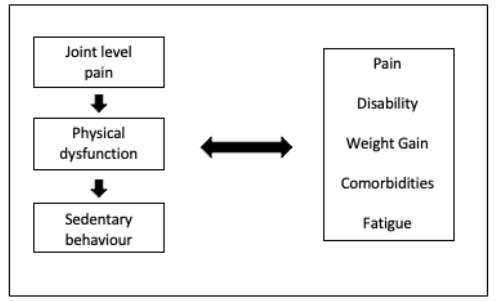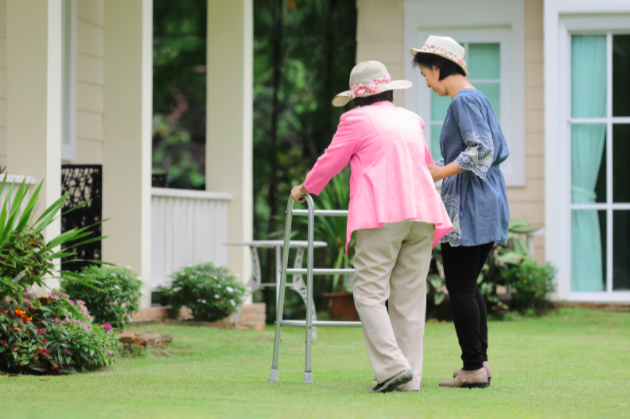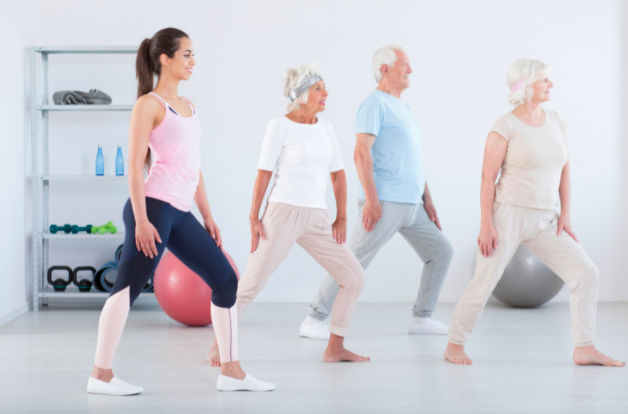Osteoarthritis (OA) is the leading cause of disability among older adults and affects an estimated 302 million people worldwide. [1] OA is a progressive disease affecting certain joints in the body, most commonly the knees and hips. [1] Physical inactivity and pain are some of the most common symptoms associated with osteoarthritis. [2] The pain and functional limitations experienced with OA generally result in people becoming more and more sedentary. However, the belief that physical activity and exercise causes an increase in pain and reduced function has resulted in a vicious cycle. Pain and the inability to move as efficiently results in sedentary behaviour which instead of reducing pain actually causes more pain, weight gain, and fatigue. This blog aims to debunk the myths associated with exercise and osteoarthritis. In fact, exercise can be considered the MOST effective non-surgical treatment for hip and knee osteoarthritis. [3]

This image depicts the viscious cycle that results from the belief that physical activity and exercise causes increased pain. The reality is that sedentary behaviour and physical inacitivty can actually lead to weight gain, comorbidites, fatgiue etc. that will actually increase pain even more!
Did you know that 60-90% of people with osteoarthritis have at least one other major medical condition? [2] Of these, the most common are hypertension, diabetes and cardiovascular disease. This is considered largely driven by the extremely sedentary lifestyle adopted by people diagnosed with osteoarthritis. [2] In addition, obesity is considered one of the most significant risk factors associated with osteoarthritis. The research has shown that a 5kg weight loss can reduce your risk of developing knee osteoarthritis by 50%. [4] So how can exercise play a role in targeting the vicious cycle of pain, reduced physical activity, physical dysfunction and ultimately a worsening of osteoarthritis and other chronic conditions?
Let’s start by pointing out the difference between physical activity and exercise. Physical activity is any bodily movement produced by the muscles that require energy expenditure. Exercise on the other hand is physical activity that is regular and done with the intention of improving or maintaining physical health and fitness. The Canadian physical activity guidelines recommend that adults participate in at least 150 minutes of moderate to vigorous physical activity each week in bouts of at least 10 minutes. Unfortunately, only 30% of people with osteoarthritis meet these guidelines. [5] The good news is that people do not have to meet these physical activity guidelines to see the benefits of exercise for pain and disability improvements. The largest incremental benefit can be seen when people who are sedentary begin being moderately active.[6] Increases in physical activity levels will not only help to improve pain and dysfunction but can also limit the severity and extent to which other medical conditions (such as the ones mentioned above) manifest.
So what are the best exercises to do if you have osteoarthritis?

Image by akaratwimages Images via Canva - Walking is a great aerobic exercise for hip osteoarthritis and knee osteoarthritis
Walking Programs
Walking is considered an effective form of exercise for people with osteoarthritis as it helps to relieve pain and promote nutrition and remodelling in the affected joint without increasing too much stress on the joint itself.[5] Walking is also a form of aerobic exercise which gets the heart pumping and provides great benefits for cardiovascular health, something that is commonly affected in people with osteoarthritis. There is no specific amount of walking that has been proven to be the ideal amount for people with osteoarthritis, however research has shown that patients with severe osteoarthritis were able to tolerate 70 minutes of brisk walking a week. [5] Those who participate in some form of walking can see improved joint stability and activity tolerance which could eventually lead to increasing the amount of walking you do to meet the physical activity guidelines of 150 minutes a week!

Image by KatarzynaBialasiewicz Images via Canva - Strengthening exercises for hip osteoarthritis and knee osteoarthritis
Strengthening and Flexibility Exercises
Strength and flexibility exercises provide great benefits to people with osteoarthritis. Some of these benefits include increased muscle strength and joint stability, improved range of motion and reduction in pain. [3] Similar to aerobic exercise, there are no conclusive findings about the best numbers of reps and sets to be completed, however participating in strength training at least 3 times a week showed significant benefits.[3] Some examples of effective strengthening and flexibility exercises for hip osteoarthritis and knee osteoarthritis include:
- Bridging
- Knee extension (seated)
- Step ups/downs
- Adductor (innter thigh) stretch

Images from Curovate App - 1) Bridging 2) Seated knee extension 3) Step up/downs 4) Hip Adductor Stretch
Pain Management during exercise
It is important to note that experiencing some pain while participating in exercise is expected and normal! Pain does not always mean harm. Research has shown that up to a 2-3 point increase in pain on a scale from 1-10 is acceptable during exercise for people who have osteoarthritis. [3] The pain should however completely disappear within 24 hours. If there happens to be a prominent “flare up” in pain it is important to stop the aggravating activity until the pain completely disappears and then start again at a lower dosage or intensity.[3] Pain should not discourage you from participating in exercise, it is an inevitable symptom of osteoarthritis. However, if monitored closely and safely, small amounts of pain during exercise could strongly help towards decreasing the amount of pain you feel overall!
Conclusion
Is it safe to exercise with osteoarthritis? Absolutely! The benefits definitely outweigh the risks. Participating in both aerobic and strengthening exercise has been shown to decrease pain, improve function and help combat the other health issues associated with osteoarthritis. It is important to find an exercise program that is best for you, one that you are comfortable with and one that you can stick to. Getting help from online physical therapists and our app Curovate can help you to find exercises that are specific to your needs. Adding exercise to your routine as a person with osteoarthritis will ultimately help you to improve pain and return to activities that are meaningful to you!
References
 |
 |
|---|
Other Blogs Related to Osteoarthritis
- Does running cause knee osteoarthritis? Can I still run after my ACL surgery? Will running wear out my knee?
- My surgeon said I have knee osteoarthritis but I don't have pain - should I get a knee replacement?
- What is Osteoarthritis?
- What's the difference between Arthritis, Osteoarthritis and Osteoarthrosis?
- How to Become More Consistent with your Exercise Program Using Curovate
- Should I be experiencing pain when I do my rehabilitation exercises?







